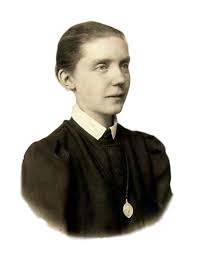Today’s missionary hero is a woman who came from a most remarkable Polish family. Her name was Maria Theresa Ledóchowska.
Maria Theresa was born on April 29, 1863 in Loosdorf, Lower Austria, the eldest of seven children. Her parents, Count Antoni Halka-Ledóchowski and Countess Josephine Salis-Zizers, were part of the Polish nobility.
As a young woman, she threw herself into the social life that nobility enjoyed. But although she enjoyed balls and fancy clothes, she developed a firm foundation in her Catholic faith thanks, in large part, to the Sisters of Loreto who taught her.
In 1885, Maria Theresa and her father both contacted smallpox. Though Maria Theresa recovered, her father died, and the family fell on hard economic times. It was at this time that her uncle, Cardinal Mieczyslaw Halka Ledóchowski took charge of the care of Maria Theresa and her siblings.
While recuperating from smallpox, Maria Theresa began to feel her life was meaningless. To help her family financially, Maria Theresa took a job as lady-in-waiting to Princess Alice of Parma, the Grand Duchess of Tuscany. This was from 1885 to 1890. Though Maria Theresa continued to enjoy the social life of the imperial palace in Salzburg, she became more focused on practicing her faith. Eventually she became a member of the Third Order of St. Francis.
In addition to her spiritual director, Maria Theresa was touched by the stories of Franciscan Missionaries of Mary who came to the court asking for financial help for their work among the lepers of Madagascar. She also became fascinated by a pamphlet of Cardinal Charles Laviegerie’s that spoke against slavery.
In 1889, Princess Alice arranged Maria Theresa to meet Cardinal Lavigerie. He encouraged Maria Theresa to establish committees in the Austrian Empire to fight against slavery. This project developed into a passion for Maria Theresa, and it led her to write a novel called Zaida showing the negative effects of slavery on women.
Maria Theresa eventually organized a sodality of women dedicated to St. Peter Claver, a patron saint of persons with dark skin, who did his work in Cartagena, Colombia. In time, the sodality became a “pious association of the faithful” in 1894, and on September 8, 1897, feast of the Nativity of Mary and death anniversary of St. Peter Claver, she and her companions became a new religious order, the Missionary Sisters of St. Peter Claver.
Because of the lack of printed material in native African languages, Sr. Maria Theresa established a publishing house the addressed that need. As the number of Sisters grew, so did the work of the Sisters in Africa.
In later life, Sr. Maria Theresa contacted tuberculosis, and on July 6, 1922, she died at the order’s motherhouse in Rome.
Mary Theresa was beatified on October 19, 1975 by Pope Paul VI. Blessed Maria Theresa’s feast day is July 6.
Interestingly, Blessed Maria Theresa is not the only one of her family to make a name for herself. Her brother Wlodimir Ledóchowski served as Superior General of the Society of Jesus, and her sister Julia was canonized in 2003 and is now known as St. Ursula Ledóchowska.



